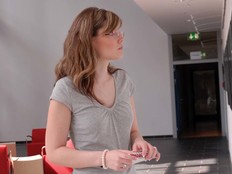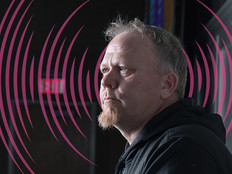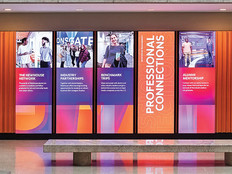Ultrathin Panels Aid in Creating a Research Environment
Ultrathin panels offer a seamless view of the coursework at the University of Illinois at Chicago.
The Electronic Visualization Laboratory at the University of Illinois at Chicago is a popular stop on the campus tour. The draw? It has a huge digital wall like no other in the country.
Last summer, EVL purchased 18 46-inch NEC Digital Display Solutions ultrathin-border panels, tiling them into an array that is six panels wide by three panels high (totaling 20 feet by 8 feet). The purpose of the array is to aid the learning experience in the classroom by replacing projectors and traditional blackboards, says Jason Leigh, director of the lab and an associate professor of computer science at the university.
LCDs themselves are nothing new for the UIC campus. In fact, EVL already has a wall with 55 panels. But what's different about this deployment is that the borders between panels are almost seamless, offering a much more cohesive production and research
environment for students and faculty.
“We're really proud that we were essentially the first to provide this kind of capability for students,” Leigh says. “Other units on campus, in medicine and physics, are asking to use our facility. We hope this is a trendsetter for other universities.”
Indeed, deployment of flat-panel displays in higher education and elsewhere is growing, says Chris Connery, vice president of DisplaySearch's PC and large format commercial display market research group.
“Along with the unfortunate need for emergency alert systems, such digital displays can also provide class schedules, act as way-finders for visitors and students alike, and be used to promote clubs, events and other activities,” says Connery.
Learning Aid
Leigh's group waited several years for a manufacturer to develop flat-panel LCDs with ultrathin borders of around 7 millimeters thick. “When the NEC LCDs came out, we jumped at the opportunity,” he says. The products are specifically designed for digital signage, and they're made to be tiled.
Lance Long, a senior research programmer at UIC, worked directly with NEC to get the specifications before they were released, and worked with CDW•G to get the product delivered in early batches. “We were among the first to receive this,” he says. “And given advancements in PC technology, we're prototyping new ways to drive these multiple displays with one computer, as we don't want complicated tech behind the curtains.”
Shortly after the team finished the summer rollout, the digital wall debuted in a Virtual School workshop organized by the National Center for Supercomputing Applications at the University of Illinois at Urbana-Champaign. Information was sent to EVL, Oak Ridge National Laboratory, the Ohio Supercomputer Center and the University of Michigan. A lecturer in Urbana-Champaign taught multicore programming to about 30 students through high-definition video conferencing. “Half of the wall showed a life-size image of the remote speaker, and the other half showed slides for the talk,” Leigh says.
Full production use of the wall – dubbed the Cyber-Commons – began in fall 2009. Students use the wall in a manner similar to a virtual screen. “EVL professor Andy Johnson used the wall last semeseter to teach a Visual Analytics class. After students completed their homework assignments, he had them use EVL's SAGE (Scalable Adaptive Graphics Environment) software to post their results onto the wall so they could talk about their work and learn from each other as a collective group,” Long points out.
Student Dennis Chau says the digital-display wall is useful for examining data sets in his visual analytics class. “For one class, we had to take IMDB database files and come up with a clever algorithm to figure out the most popular movie stars,” he explains.
Chau says using the display wall helped him see how the files interlink with one another and how certain attributes in the database may help. The Cyber-Commons is also useful for weekly meetings. “It allows us to showcase what we've been doing that week and what's going on with our research to help us solve issues that we may be facing,” he says.
The wall is regularly used by the physics department, including a seminar with collaborators at Los Alamos National Laboratory and the European Organization for Nuclear Research (CERN) in Geneva. And Leigh intends to use it this spring to teach his video game programming course, which he has been teaching for the past five years in collaboration with Louisiana State University over high-definition video.
Other major projects making use of the wall include research in computer graphics, visualization, human computer interaction and advanced networking. “The process of unleashing this to the students allows us to better understand how people in the future will make best use of this kind of technology,” Long says. He's working on future technology and interfaces to make the wall truly user friendly.
EVL Teamwork
The EVL team performed the entire installation, configuration and setup. “Once we figured out how to put it together, Adler Planetarium visited us to learn how to do it,” Leigh says. (For more on the Adler Planetarium installation, visit biztechmagazine.com/adler409.)
Because the lab uses the NEC LCDs in a classroom environment (they were designed for digital signage), there were several technical hurdles to overcome. “We needed to do a lot of configuration to make them functional in our setting,” Long says.
For starters, the EVL didn't do a traditional wall-mounting of the displays. “We had to design a free-standing wall-mounting solution and still allow airflow between panels,” Long says.
The mount had to be rigid and secure, and also accommodate the mounting of speakers and other audio equipment. Students and a design engineer on staff helped develop a solution. Once the team had the pieces in place, the digital display went up in a few days.
Another important issue was inputs, which typically don't change for commercial digital signage displays. However, the lab uses about eight different inputs in a day, connecting a variety of notebook computers and video conferencing equipment. “We can drive the entire display from one computer,” Long says.
One computer connected to the wall can support network connections of up to 20 gigabits per second. The SAGE middleware software developed by EVL helps the system use all the pixels and streams video from remote sites around the world. The NEC displays also include several intelligent features, such as remote management, color calibration, a carbon footprint meter and scalable tiling.
After working out the initial challenges, Long says that for the most part the Cyber-Commons is self-sufficient. “We still see issues when we switch laptops. Every laptop has different signals, and every input device is a little different.”
Leigh and his team are already working on designing an even larger digital-signage array. “We've written another grant proposal to build the next generation of this, but in three dimensions,” Leigh says. He expects NEC to release the next generation of LCD panels in about a year or so, and the digital wall he envisions would use as many as 60 of them.
About the Lab
The University of Illinois at Chicago's Electronic Visualization Laboratory is an interdisciplinary graduate research lab that combines art and computer science. The lab researches computer graphics and visualization, which is the process of turning data into meaningful images.
The lab is a joint effort of UIC's College of Engineering and the School of Art & Design, representing the oldest formal collaboration between engineering and art in the United States. “We have undergraduate and graduate students from a wide variety of disciplines – everything from computer science to medicine to art and design,” says Jason Leigh, lab director and an associate professor of computer science at the university.







